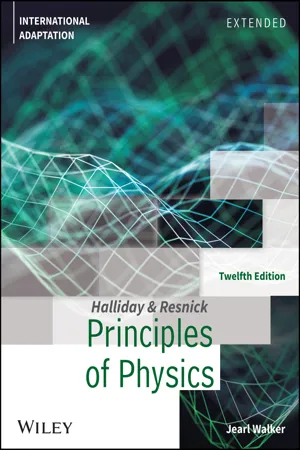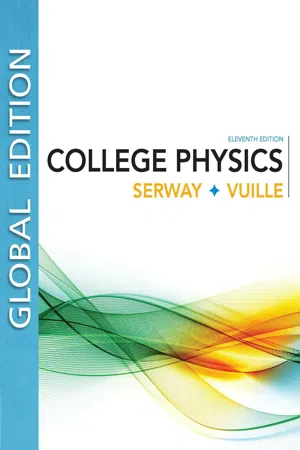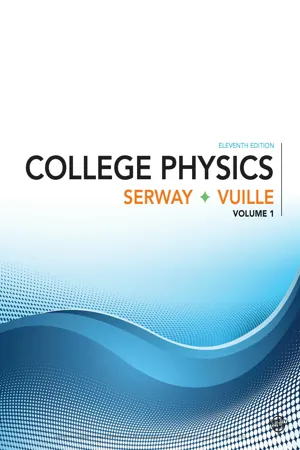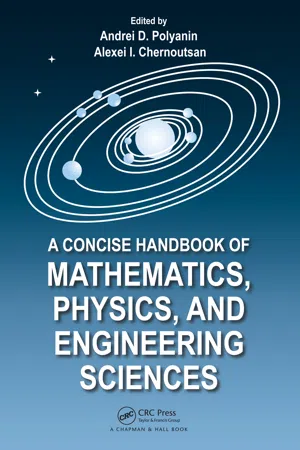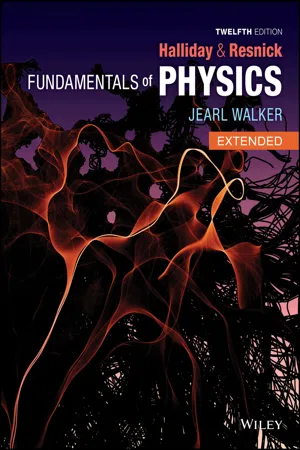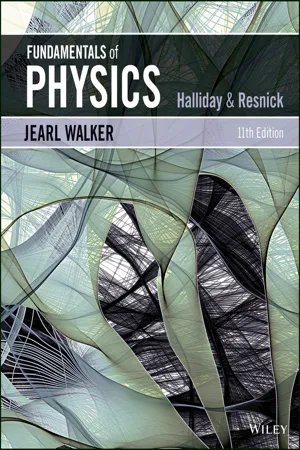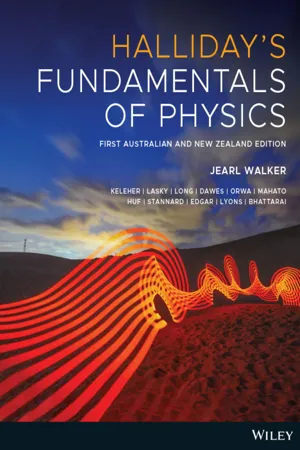Physics
Spring Potential Energy
Spring potential energy is the stored energy in a compressed or stretched spring due to its deformation from its equilibrium position. This energy is potential because it has the potential to do work when the spring is released and returns to its original shape. The amount of spring potential energy is directly proportional to the amount of deformation.
Written by Perlego with AI-assistance
Related key terms
1 of 5
8 Key excerpts on "Spring Potential Energy"
- David Halliday, Robert Resnick, Jearl Walker(Authors)
- 2023(Publication Date)
- Wiley(Publisher)
(8.1.9) Elastic Potential Energy Elastic potential energy is the energy associated with the state of compression or extension of an elastic object. For a spring that exerts a spring force F = −kx when its free end has displacement x, the elastic potential energy is U(x) = 1 _ 2 kx 2 . (8.1.11) REVIEW & SUMMARY The reference configuration has the spring at its relaxed length, at which x = 0 and U = 0. Mechanical Energy The mechanical energy E mec of a system is the sum of its kinetic energy K and potential energy U: E mec = K + U. (8.2.1) An isolated system is one in which no external force causes energy changes. If only conservative forces do work within an isolated system, then the mechanical energy E mec of the system cannot change. This principle of conservation of mechanical energy is written as K 2 + U 2 = K 1 + U 1 , (8.2.6) in which the subscripts refer to different instants during an energy transfer process. This conservation principle can also be written as ∆E mec = ∆K + ∆U = 0. (8.2.7) Potential Energy Curves If we know the potential energy function U(x) for a system in which a one-dimensional force F(x) acts on a particle, we can find the force as F(x) = − dU(x) _ dx . (8.3.2) If U(x) is given on a graph, then at any value of x, the force F(x) is the negative of the slope of the curve there and the kinetic energy of the particle is given by K(x) = E mec − U(x), (8.3.4) where E mec is the mechanical energy of the system. A turning point is a point x at which the particle reverses its motion (there, K = 0). The particle is in equilibrium at points where the slope of the U(x) curve is zero (there, F(x) = 0). Work Done on a System by an External Force Work W is energy transferred to or from a system by means of an external force acting on the system. When more than one force acts on 200 CHAPTER 8 Potential Energy and Conservation of Energy a system, their net work is the transferred energy.- eBook - PDF
- Raymond Serway, Chris Vuille(Authors)
- 2017(Publication Date)
- Cengage Learning EMEA(Publisher)
WCN 02-300 5.5 | Spring Potential Energy 137 Unless otherwise noted, all content on this page is © Cengage Learning. 5.5 Spring Potential Energy Springs are important elements in modern technology. They are found in machines of all kinds, in watches, toys, cars, and trains. Springs will be introduced here, then studied in more detail in Topic 13. Work done by an applied force in stretching or compressing a spring can be recov- ered by removing the applied force, so like gravity, the spring force is conservative, as long as losses through internal friction of the spring can be neglected. That means a potential energy function can be found and used in the work–energy theorem. Figure 5.21a shows a spring in its equilibrium position, where the spring is nei- ther compressed nor stretched. Pushing a block against the spring as in Figure 5.21b compresses it a distance x. Although x appears to be merely a coordinate, for springs it also represents a displacement from the equilibrium position, which for our pur- poses will always be taken to be at x 5 0. Experimentally, it turns out that doubling a given displacement requires twice the force, and tripling it takes three times the force. This means the force exerted by the spring, F s , must be proportional to the displacement x, or F s 5 2kx [5.16] where k is a constant of proportionality, the spring constant, carrying units of new- tons per meter. Equation 5.16 is called Hooke’s law, after Sir Robert Hooke, who discovered the relationship. The force F s is often called a restoring force because the spring always exerts a force in a direction opposite the displacement of its end, tending to restore whatever is attached to the spring to its original position. For positive values of x, the force is negative, pointing back towards equilibrium at x 5 0, and for negative x, the force is positive, again pointing towards x 5 0. - eBook - PDF
- Raymond Serway, Chris Vuille(Authors)
- 2017(Publication Date)
- Cengage Learning EMEA(Publisher)
It’s important to remember that the work done by gravity and springs in any given physical system is already included on the right-hand side of Equation 5.18 as potential energy and should not also be included on the left as work. Figure 5.21c shows how the stored elastic potential energy can be recovered. When the block is released, the spring snaps back to its original length, and the stored elastic potential energy is converted to kinetic energy of the block. The elas- tic potential energy stored in the spring is zero when the spring is in the equilib- rium position (x 5 0). As given by Equation 5.17, potential energy is also stored in the spring when it’s stretched. Further, the elastic potential energy is a maximum Spring Potential Energy c Copyright 2018 Cengage Learning. All Rights Reserved. May not be copied, scanned, or duplicated, in whole or in part. WCN 02-200-202 5.5 | Spring Potential Energy 139 Unless otherwise noted, all content on this page is © Cengage Learning. when the spring has reached its maximum compression or extension. Finally, because PE s s is proportional to is proportional to x 2 , the potential energy is always positive when the spring is not in the equilibrium position. In the absence of nonconservative forces, W nc nc 5 0, so the left-hand side of Equation 5.18 is zero, and an extended form for conservation of mechanical energy results: (KE 1 PE g g 1 PE s s ) i 5 (KE 1 PE g g 1 PE s s ) f [5.19] Problems involving springs, gravity, and other forces are handled in exactly the same way as described in the problem-solving strategy for conservation of mechani- cal energy, except that the equilibrium point of any spring in the problem must be defined in addition to the zero point for gravitational potential energy. Quick Quiz 5.5 Calculate the elastic potential energy of a spring with spring constant k 5 225 N/m that is (a) compressed and (b) stretched by 1.00 3 10 22 m. - Andrei D. Polyanin, Alexei Chernoutsan(Authors)
- 2010(Publication Date)
- CRC Press(Publisher)
Consequently, the potential energy of the elastic spring is E p = 1 2 kx 2 , where zero energy corresponds to the undeformed spring. Example 3. The work done by friction or resistive forces is negative on each segment of the path and also along a closed path. Consequently, these forces do not satisfy the condition of being conservative and are nonconservative. The potential energy of conservative interation of two particles can be treated as the potential energy of one particle in the field generated by the other. The result is independent of which particle is considered to be the field source. ◮ Relation between force and potential energy. By writing equation (P1.5.2.1) for two close particles lying on the x -axis and separated by a distance dx , one obtains E p ( x ) – E p ( x + dx ) = F x dx . It follows that the projection F x of the force F onto the x -axis is determined by the derivative of the potential energy: F x = – ∂E p ∂x . (P1. 5 . 2 . 2 ) The partial derivative means that E p is treated as a function of only x here. The same is obviously valid for projections on any other direction. Consequently, the vector of force equals the opposite of the gradient of the potential energy: F = – parenleftbigg ∂E p ∂x i + ∂E p ∂y j + ∂E p ∂z k parenrightbigg = – grad E p , (P1. 5 . 2 . 3 ) where i , j , and k are unit vectors in the x -, y -, and z -axis, respectively. For central field, formula (P1.5.2.2) becomes F r = – dE p ( r ) dr . (P1. 5 . 2 . 4 ) 418 P HYSICAL F OUNDATIONS OF M ECHANICS P1.5.3. Mechanical Energy of a System of Particles. Law of Conservation of Mechanical Energy ◮ Mechanical energy. The mechanical energy of a system of particles is defined as the sum of its kinetic energy, the internal potential energy due to interaction between the particles, and the potential energy in an external field: E mech = summationdisplay j m j v 2 j 2 + summationdisplay j < n E jn + summationdisplay j E e j .- eBook - PDF
- David Halliday, Robert Resnick, Jearl Walker(Authors)
- 2021(Publication Date)
- Wiley(Publisher)
(8.1.7) If the reference point of the particle is set as y i = 0 and the cor- responding gravitational potential energy of the system is set as U i = 0, then the gravitational potential energy U when the par- ticle is at any height y is U( y) = mgy. (8.1.9) Elastic Potential Energy Elastic potential energy is the energy associated with the state of compression or extension of an elastic object. For a spring that exerts a spring force F = −kx when its free end has displacement x, the elastic potential energy is U(x) = 1 _ 2 kx 2 . (8.1.11) Additional examples, video, and practice available at WileyPLUS 210 CHAPTER 8 POTENTIAL ENERGY AND CONSERVATION OF ENERGY is not involved, the work done on the system and the change ∆E mec in the mechanical energy of the system are equal: W = ∆E mec = ∆K + ∆U. (8.4.1, 8.4.2) When a kinetic frictional force acts within the system, then the thermal energy E th of the system changes. (This energy is asso- ciated with the random motion of atoms and molecules in the system.) The work done on the system is then W = ∆E mec + ∆E th . (8.4.9) The change ∆E th is related to the magnitude f k of the frictional force and the magnitude d of the displacement caused by the external force by ∆E th = f k d. (8.4.7) Conservation of Energy The total energy E of a system (the sum of its mechanical energy and its internal energies, including thermal energy) can change only by amounts of energy that are transferred to or from the system. This experimental fact is known as the law of conservation of energy. If work W is done on the system, then W = ∆E = ∆E mec + ∆E th + ∆E int . (8.5.1) If the system is isolated (W = 0), this gives ∆E mec + ∆E th + ∆E int = 0 (8.5.2) and E mec,2 = E mec,1 − ∆E th − ∆E int , (8.5.3) where the subscripts 1 and 2 refer to two different instants. Power The power due to a force is the rate at which that force transfers energy. - eBook - PDF
- David Halliday, Robert Resnick, Jearl Walker(Authors)
- 2020(Publication Date)
- Wiley(Publisher)
● If the reference point of the particle is set as y i = 0 and the corresponding gravitational potential energy of the system is set as U i = 0, then the gravitational potential energy U when the particle is at any height y is U( y) = mgy. ● Elastic potential energy is the energy associated with the state of compression or extension of an elastic object. For a spring that exerts a spring force F = −kx when its free end has displacement x, the elastic potential energy is U(x) = 1 2 kx 2 . ● The reference configuration has the spring at its relaxed length, at which x = 0 and U = 0. Key Ideas 8.01 Distinguish a conservative force from a nonconser- vative force. 8.02 For a particle moving between two points, identify that the work done by a conservative force does not depend on which path the particle takes. 8.03 Calculate the gravitational potential energy of a par- ticle (or, more properly, a particle–Earth system). 8.04 Calculate the elastic potential energy of a block– spring system. 150 This is a pretty formal definition of something that is actually familiar to you. An example might help better than the definition: A bungee-cord jumper plunges from a staging platform (Fig. 8-1). The system of objects consists of Earth and the jumper. The force between the objects is the gravitational force. The configuration of the system changes (the separation between the jumper and Earth decreases — that is, of course, the thrill of the jump). We can account for the jumper’s motion and increase in kinetic energy by defining a gravitational potential energy U. This is the energy associated with the state of separation between two objects that attract each other by the gravitational force, here the jumper and Earth. When the jumper begins to stretch the bungee cord near the end of the plunge, the system of objects consists of the cord and the jumper. The force between the objects is an elastic (spring-like) force. The configuration of the system changes (the cord stretches). - eBook - PDF
- David Halliday, Robert Resnick, Jearl Walker(Authors)
- 2018(Publication Date)
- Wiley(Publisher)
● If the reference point of the particle is set as y i = 0 and the corresponding gravitational potential energy of the system is set as U i = 0, then the gravitational potential energy U when the particle is at any height y is U( y) = mgy. ● Elastic potential energy is the energy associated with the state of compression or extension of an elastic object. For a spring that exerts a spring force F = −kx when its free end has displacement x, the elastic potential energy is U(x) = 1 2 kx 2 . ● The reference configuration has the spring at its relaxed length, at which x = 0 and U = 0. Key Ideas 8.01 Distinguish a conservative force from a nonconser- vative force. 8.02 For a particle moving between two points, identify that the work done by a conservative force does not depend on which path the particle takes. 8.03 Calculate the gravitational potential energy of a par- ticle (or, more properly, a particle–Earth system). 8.04 Calculate the elastic potential energy of a block– spring system. 177 This is a pretty formal definition of something that is actually familiar to you. An example might help better than the definition: A bungee-cord jumper plunges from a staging platform (Fig. 8-1). The system of objects consists of Earth and the jumper. The force between the objects is the gravitational force. The configuration of the system changes (the separation between the jumper and Earth decreases — that is, of course, the thrill of the jump). We can account for the jumper’s motion and increase in kinetic energy by defining a gravitational potential energy U. This is the energy associated with the state of separation between two objects that attract each other by the gravitational force, here the jumper and Earth. When the jumper begins to stretch the bungee cord near the end of the plunge, the system of objects consists of the cord and the jumper. The force between the objects is an elastic (spring-like) force. The configuration of the system changes (the cord stretches). - David Halliday, Jearl Walker, Patrick Keleher, Paul Lasky, John Long, Judith Dawes, Julius Orwa, Ajay Mahato, Peter Huf, Warren Stannard, Amanda Edgar, Liam Lyons, Dipesh Bhattarai(Authors)
- 2020(Publication Date)
- Wiley(Publisher)
• If the reference point of the particle is set as y i = 0 and the corresponding gravitational potential energy of the system is set as U i = 0, then the gravitational potential energy U when the particle is at any height y is U (y) = mgy. • Elastic potential energy is the energy associated with the state of compression or extension of an elastic object. For a spring that exerts a spring force F = −kx when its free end has displacement x, the elastic potential energy is U (x) = 1 2 kx 2 . • The reference configuration has the spring at its relaxed length, at which x = 0 and U = 0. Why study physics? Whether climbing the 134-metre-high top arch of Sydney Harbour Bridge or enjoying the 43-metre adrenaline-fuelled bungy jump at Kawarau Gorge Suspension Bridge in Queenstown, you are experiencing a change in your potential energy and conservation of energy. 1 Work and potential energy FIGURE 8.1 A tomato is thrown upward. As it rises, the gravitational force does negative work on it, decreasing its kinetic energy. As the tomato descends, the gravitational force does positive work on it, increasing its kinetic energy. Negative work done by the gravitational force Positive work done by the gravitational force In chapter 7 we discussed the relation between work and a change in kinetic energy. Here we discuss the relation between work and a change in potential energy. Let us throw a tomato upward. We already know that as the tomato rises, the work W g done on the tomato by the gravitational force is negative because the force transfers energy from the kinetic energy of the tomato (figure 8.1). We can now finish the story by saying that this energy is transferred by the gravitational force to the gravitational potential energy of the tomato–Earth system. The tomato slows, stops, and then begins to fall back down because of the gravitational force.
Index pages curate the most relevant extracts from our library of academic textbooks. They’ve been created using an in-house natural language model (NLM), each adding context and meaning to key research topics.
